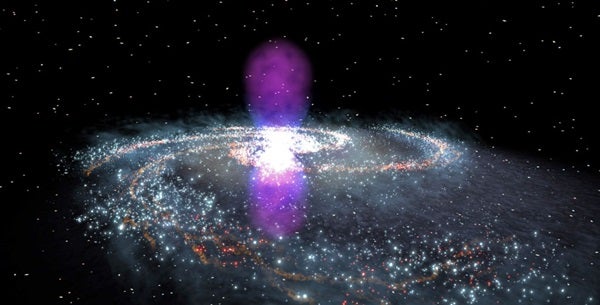A proton’s energy while at rest is about 1 million electronvolts (MeV), but when it moves, its energy of motion becomes important. For reference, visible light has an energy of about 1.5 to 3.5 eV. The only way to produce photons at energies much higher than about 1,000 MeV (which is solidly in the gamma-ray range) is to have protons moving at nearly the speed of light. In this case, the particles lose energy in other ways and can make gamma rays — but not by annihilation. Although we’re still not positive what causes the Milky Way’s bubbles, matter-antimatter collisions are not a possibility. — Doug Finkbeiner, Harvard-Smithsonian Center for Astrophysics, Cambridge, Massachusetts
Could the huge gamma-ray bubbles that extend above and below the center of the Milky Way be a boundary of matter and antimatter, whose collision emits gamma rays?
Pranathi Swamy, Andhra Pradesh, India
Huge gamma-ray bubbles emanate from the Milky Way’s center. Shown as purple in this illustration, these structures have well-defined edges, which indicate that an extremely energetic event created them. The collision and annihilation of matter and antimatter particles, however, is not a possible cause. NASA’s Goddard Space Flight Center
When matter and antimatter annihilate each other, the collision produces radiation at a distinct spectral line. This emission’s energy corresponds to the mass of the particles that annihilated (for a two-photon annihilation) or less (for a three-photon annihilation).










